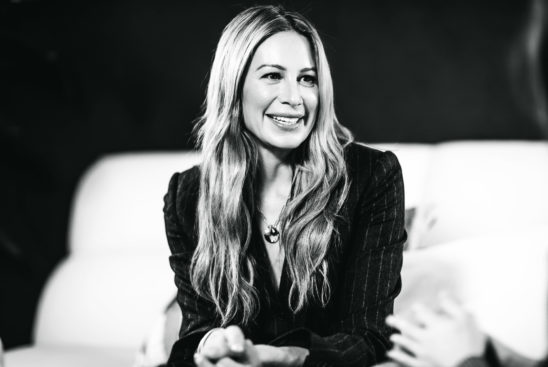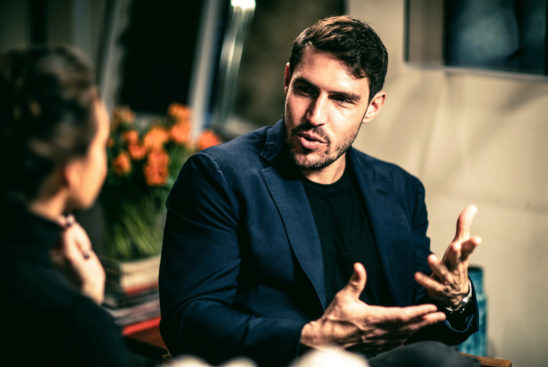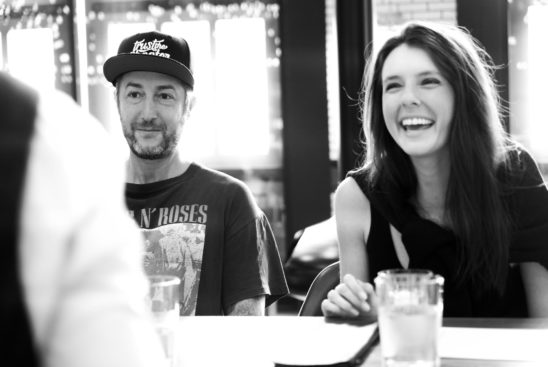As the creative director at large at GQ, I imagine many opportunities come your way for collaborations. What was it about CB2 that made you and GQ want to partner with CB2 on a furniture line?
Jim Moore [Creative Director At Large, GQ]: It probably started with my obsession with CB2. I’ve been watching it from the beginning and I’ve noticed in the last couple years — especially when Lenny Kravitz and Kravitz Design came on to do his collection and recently with Goop — that there’s some really magic sauce over there. There are some really creative people who are letting other brands participate in collaborations … Magazines are no longer just magazines, they’re brands, [so when I brought up the idea] the corporate people at Condé Nast were excited about it but a little cautious about the fact that furniture is something we haven’t entered into as a category. I thought, “Well, it doesn’t hurt to call.” … Somehow six days later [Ryan Turf and I] were in New York, so [Ryan] was as excited as we were about it. I want to know, what was the reaction when Condé Nast called you and asked if this is something you’d even consider or be interested in?
Ryan Turf [President, CB2]: The reaction was excitement. It came to me and I’m a personal fan of GQ. I’ve been reading the magazine for 20 years and I’ve always followed and had a lot of respect for Jim. GQ has been a great inspiration in the design world. Fashion and design is so intertwined. I read GQ and GQ Style and funnily enough, three or four months earlier I wondered why they aren’t in the home space more because of the strength of the brand, the taste level, so much great editorial content and the connection between home and fashion. When I got the email I thought, “Whoa, this is exciting.” I got back right away and to Jim’s point about a week later we met in New York.
Did you meet for a drink, dinner or coffee?
Ryan: We should have met for a drink but we met in a conference room.
Jim: Yeah, we met in a conference room. I think I was in a rush and doing a style video for GQ. We only had a few minutes but with CB2 and GQ it was love at first sight. I could see the whole thing from the minute I came up with the idea which just felt super organic. These two DNAs just match perfectly. I was in the CB2 store on Broadway in New York and the idea just kind of came to me. Lenny Kravitz did it and it looked like the stuff was selling. We’re always looking for the men’s lane, obviously, so [I wondered], “Is there a furniture line that could be perceived as a GQ collection and could [function] the same way we encourage guys to put their wardrobe together? Would it be possible to do a furniture collection that looked really good if it was all matched but then looked really great if it was really unmatched?” Which kind of ties into the idea of personal style which is getting it right but disrupting it a bit.
How do you lead a team to bring a vision to life?
Ryan: Stick with vision. For a magazine to partner with a retailer, at first you might not know how it’s going to work. These two brands just make sense together. We’ve done multiple partnerships, as has GQ, and when there’s uncertainty of how things are going to come together, you’ve just got to stick with the original vision. For me, it was the love of GQ and the brand and the magazine and everything it stood for and everything Jim and the team over there has done. I think that’s how you start and you’ve got to trust each other, too.
Jim: The minute we met in that conference room it was a complete love fest. It was two brands that were dying to meet. Two brands that were dying to be put together like tequila and soda. To Ryan’s point, I think it’s the long leash that you gave us to be as creative as possible. We were in this space we hadn’t really been in before. We just hadn’t really done anything like this. So I think it was just a matter of a couple phone calls with Ryan and his team and he was like, “I don’t care if you sketch something down on a napkin or whatever you do, but think big or think small or think a lot of pieces and come up with something. We’ll meet in a couple months and just show it to us.” It’s that long leash and trust in both of our brands and [thinking about] how this could collide in a really beautiful way.
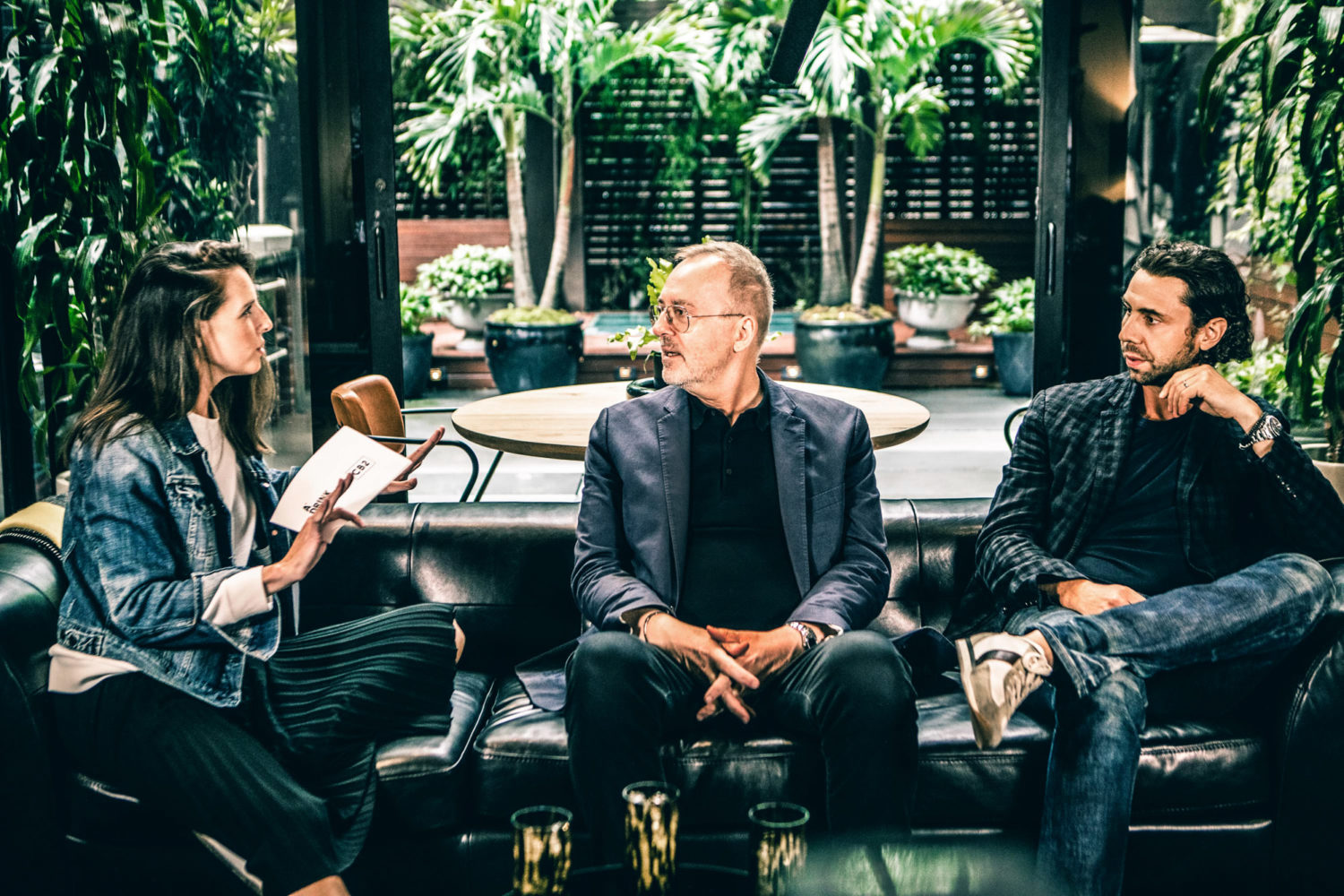

Are there any rules you can follow for your home that are similar to some rules in fashion?
Jim: When everything is coordinated and goes together, it’s a very safe way to do things but it’s always the thing that doesn’t look like it should be in the room that is the most interesting. This particular collection was kind of heaped in industrial design from the 20s, 30s, 70s and a little bit of the 80s. It’s this amazing Cuisinart of all of these different eras. Whether it’s post-World War II or the 80s when everybody wanted gray industrial carpeting and plywood furniture and it was a little bit more lo-fi, the inspirations came from a lot of different places but I’d have to say it’s the ability to see this collection in a number of different ways. The unexpected ways being the more interesting things which is what dressing with good personal style is all about.
Where do you begin when you want to create your personal style for your home?
Ryan: Furniture and a sofa. A sofa sets the mood of the room and is the most used piece of furniture outside of the kitchen or dining room table for meals. At CB2 we really believe in mix and uniqueness. Relating to Jim’s point about fashion, mixing things up and pairing different things that might be unexpected but when they come together they look great … I think if you’re going to start fresh and really want to set the vibe of your place, start and invest in a piece that really makes you happy. And then have more fun with the accessories.
Jim: Think of it as a classic leather jacket. Something that is classic, maybe it’s a motorcycle jacket, maybe it’s just a simple bomber, but it’s a classic piece that gets better with age. Ryan and I were really adamant about the fact that the leather on this sofa will age really quickly. I’m not saying it will break down and get destroyed but it’s meant to show the wrinkles and wear and get even more cool and masculine as time goes on. That’s the same way as a leather jacket. If this is the key piece that you buy, it’s your leather jacket and you can wear your leather jacket ten different ways.
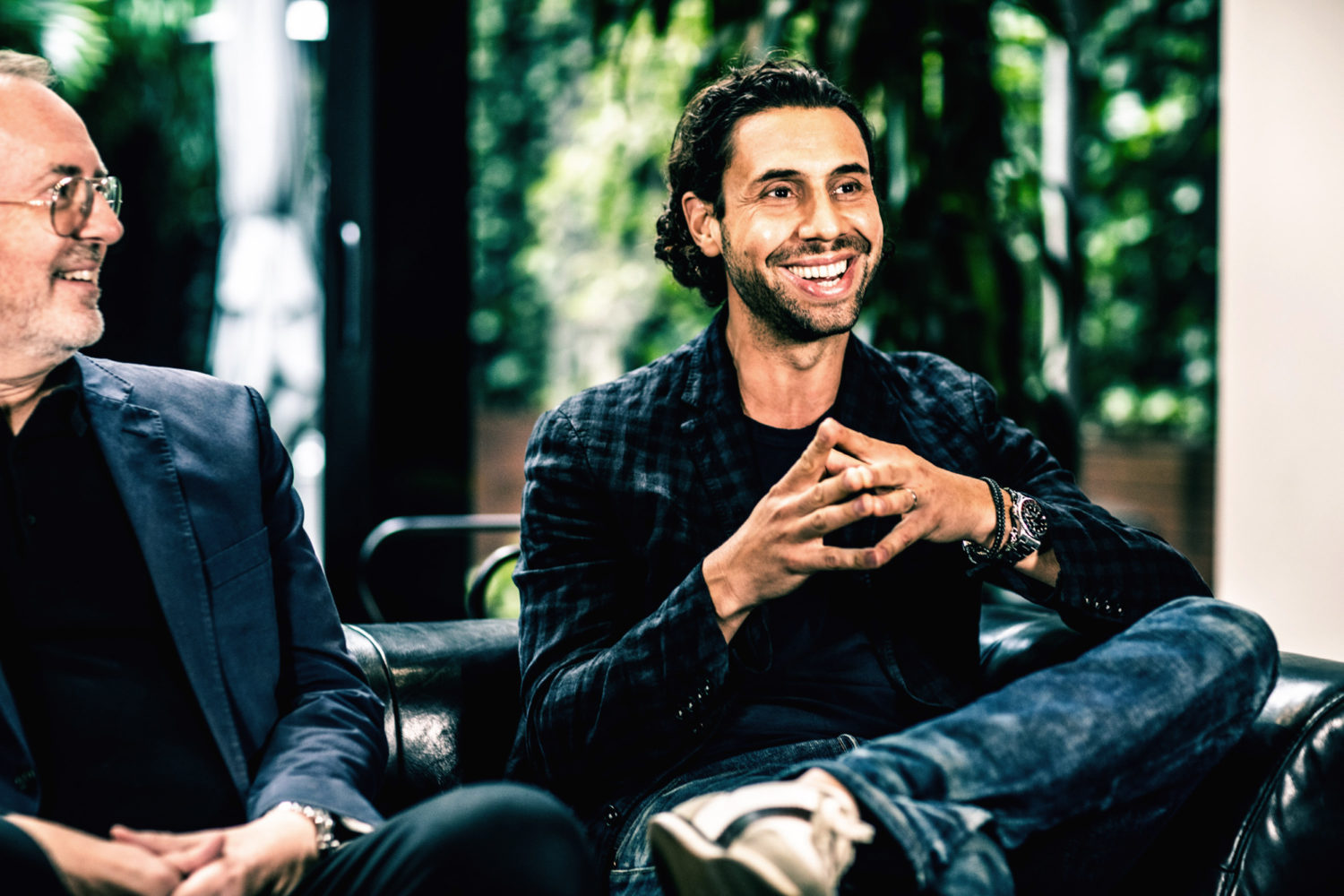

What is something in fashion that will never go out of style?
Jim: For me, it’s a black cashmere turtleneck. That’s part of what my uniform is. I’ve been trying to get more guys into wearing a turtleneck and that is something that has a little bit [of pushback]— 60 percent of guys are like, “I can’t cover my Adam’s apple or I’ll die or something.” What I love about a turtleneck is that it’s totally functional, it looks great on everyone, it covers up a neck or chin you’re not that proud of, but also it can be the start of anything in your wardrobe. You can put a jean jacket over a black turtleneck, you can put this sports jacket over a black turtleneck, you can wear it with jeans and it has a little bit of swank to it, a little bit of sex appeal because it is a little bit of a 70s throwback. If you invest in a good black cashmere turtleneck suddenly you’ve only got one thing but you’ve upgraded your entire wardrobe.
You’ve spent four decades with GQ starting as an intern in 1979. What is it about GQ that makes it stand the test of time for you?
Jim: I’m really that person who never looked at his watch. I love my job that much. I was born in the Twin Cities, I came to New York, I wanted to get this job, I got this job and I held onto it. It’s so creatively stimulating. You churn out a new magazine with new content every month, so you have to be a deadline junkie and someone who wants to be topical and is really interested in ideas and content. It’s also the constant circus and moving cycle of the fashion business that’s really fun, too. You have these two orbits that are kind of going crazy, so you do have to be the person who likes a lot of stimuli and creativity. I think if I look at it from what I have learned and what my favorite thing to do is, it’s really to study men’s ideals and that could be the shopping habits of men over forty years or the history of men’s fashion. When I first started at the magazine it was the Reagan-era and the shoulders were getting big and then we softened it and got minimal and now we’re completely outrageous. That’s what’s really fun about it, the ever-changing aspect. And just helping guys. Helping guys put their pads together was a really important assignment for me and for the magazine. I think they need as much help with that as they do with wearing a suit or a leather jacket.
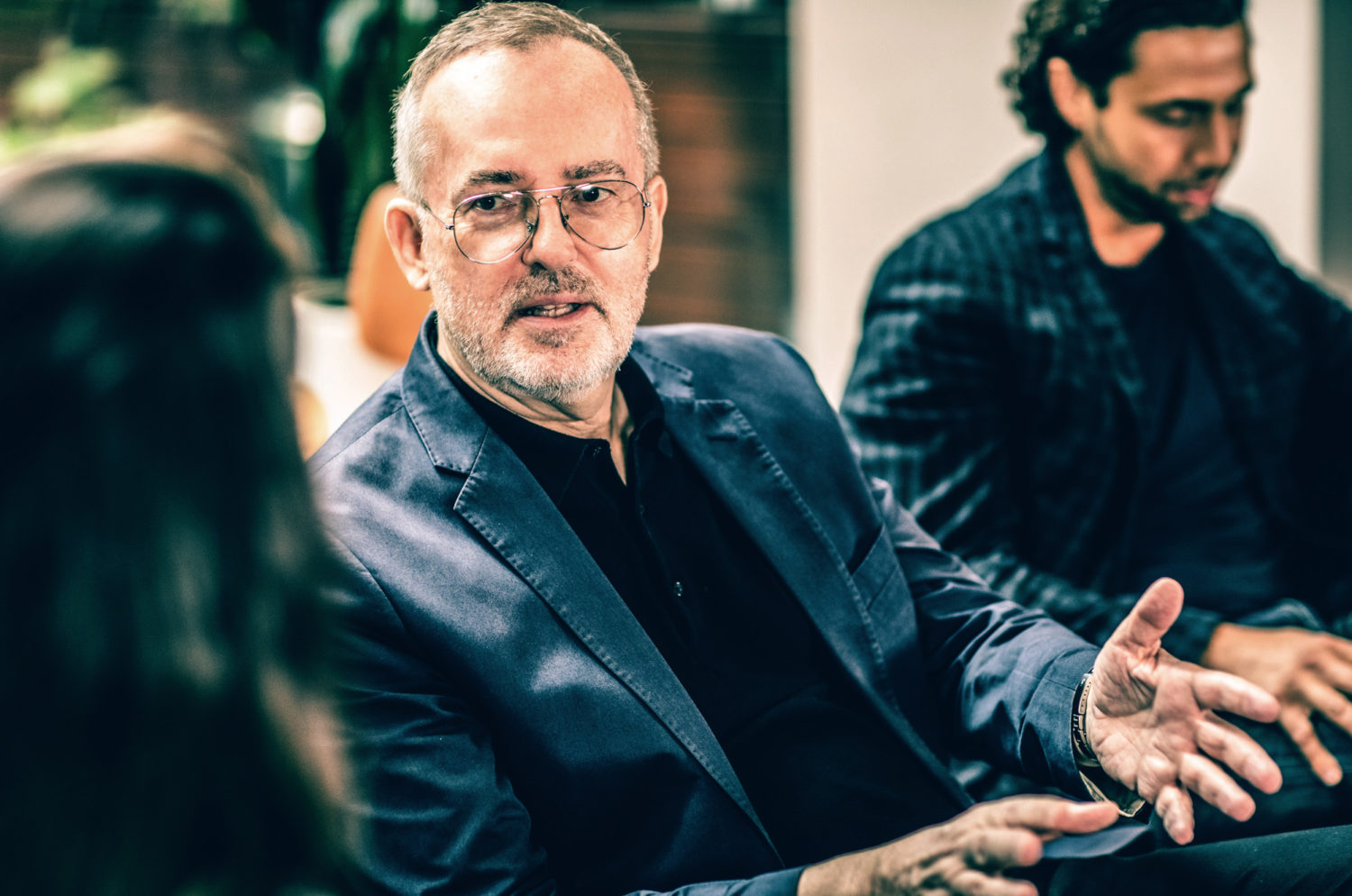

What’s the biggest debacle that happened at a GQ shoot behind the scenes?
Jim: I had someone not show up on set, I had a model destroy a hotel room. That’s a good one, right? This was before the whole celebrity era happened in the mid-90s when GQ was still using a lot of models. This person is going to remain nameless but I went a very far distance — Australia — for 40 minutes to shoot a particular celebrity and that particular celebrity just wanted to wear his grimy t-shirt and not get groomed and it was a challenge to get him in the suit. Of course later he said those are the best pictures he’d ever seen. Those are the kind of in-the-trenches stories you never think you’re going to come up against. You think you’re going to fly all that distance and make this guy look like a cover boy but there’s some resistance.
Most fun GQ cover shoot or fitting?
Jim: Probably [former President Barack] Obama. And it’s interesting because I’ve shot him twice: when he was leaving the Senate and going into the presidency and right before he left the presidency. Both times I was panicked because I knew I couldn’t change what he was wearing and I was so nervous he was going to come in with a blue shirt and an orange tie, and of course he came in with a blue shirt and an orange tie. I was able to convince him to go home and change his suit… because you’re not allowed to dress the president. So, the second time I shot him he said, “It’s great to see you again,” and I said, “Do you remember me?” because it was eight years ago. And he said, “Yeah, I do. You’re the guy who didn’t like my tie and I can tell by the way you’re looking at me now that you don’t like my tie today.” I said, “Well, do you have a black one?” because that was a pattern that I thought would go crazy in digital and he said, “Yeah, I’ll go upstairs and get it.” We were at the White House and he changed the tie. What I loved about him is that not only did he wear the suit but his swagger was just electric. It wasn’t the longest shoot of my life in those 20 or 30 minutes but that was the most memorable moment of my career.
Is Barack comfortable in front of the camera?
Jim: He is comfortable. I call myself a little bit of an aggressive stylist. I run in a lot to fix things because you only have that one time to get it on film. You have to be careful with him because the secret service will just grab you, so you have to ask him before you go in and fix his tie. I found myself wanting to jump in. Just a really incredible, charismatic guy and he knows how to rock a suit. If I had to say what’s the pinnacle, I’d say that’s it.
What do you attribute to your success?
Jim: I think that there’s a difference between putting clothes on yourself and making other people look good. A lot of people have that misconception and think you can dress other people because you’re a really snappy dresser. This might be getting off subject, but I’d much rather wear a lab coat and put ten guys in a room and dress them. You have to think that way, we’re almost like scientists of fashion, in a way.

What was the most challenging moment in your career?
Ryan: First, I think it’s hard to follow the Obama story. Much different career than Jim’s … I think one of our most challenging moments was about five years ago. This goes back to Jim noticing the brand starting to evolve and change. A lot of people had a lot of opinions and thoughts on where CB2 should go. Back to Jim’s point, we made a conscious decision five years ago to really evolve the brand from where it had been. It really shifted from what people thought of as the younger little sister of Crate & Barrel to a unique brand that could stand on its own. Very much still part of Crate & Barrel and its heritage but it needed to evolve. It was nerve-wracking. We changed our logo which is always very stressful for brands, and we really shifted directions and went for it. We partnered with Lenny Kravitz and before that, that would have been unheard of.
Jim: I remember that moment when CB2 really changed, too. I still have a credenza up in my bedroom from the first iteration of CB2. I’m sure it was nerve-wracking at first, but you really set it apart from everything else that’s out there by changing it and disrupting it. That was when we really caught wind of it and suddenly it was like… fashion is the same way, it’s all about this high-low mix and the fact that you don’t know if this [top] is H&M or Prada. That’s the world we’re living in and that has its challenges, especially from a designer standpoint. I was so impressed with the whole process of working with Ryan and the CB2 team, and just the quality control and the fact that we handed them schematics that were pretty detailed but the product and prototype stage that came back was just outstanding. Just really, really, proud of it all.
If you could have a drink with anyone, who would it be?
Ryan: I’m going to stick with a musician like Mick Jagger, or I would throw Bruce Springsteen in … To sit down with guys like that when being a rockstar was truly being a rockstar and just hearing what they went through would be truly inspirational and exciting.
Jim: For me the superheroes are the photographers because that’s who I work with. I always tell people that my favorite role is to just stand a half a step behind a photographer. By standing a half a step behind a photographer, you can be there to whisper in their ear if they need your advice on how to take a GQ picture or you can just give them a long leash and in most cases we do like Ryan gave us. There’s one photographer — unfortunately he died before I was able to work with him and I was set to work with him — and that’s Helmut Newton. I’m a Helmut Newton superfan. The crew would go out together and have drinks into the night. I think I would just sit next to him and be completely tongue-tied because I’m such a fan of his work. I’d probably ask way too many questions and embarrass myself.

Thank you to our partner CB2. View the collection here.
This interview has been edited and condensed for clarity.
Did you enjoy this feature? Subscribe to our newsletter and never miss a drink, we promise we’ll never spam you!

